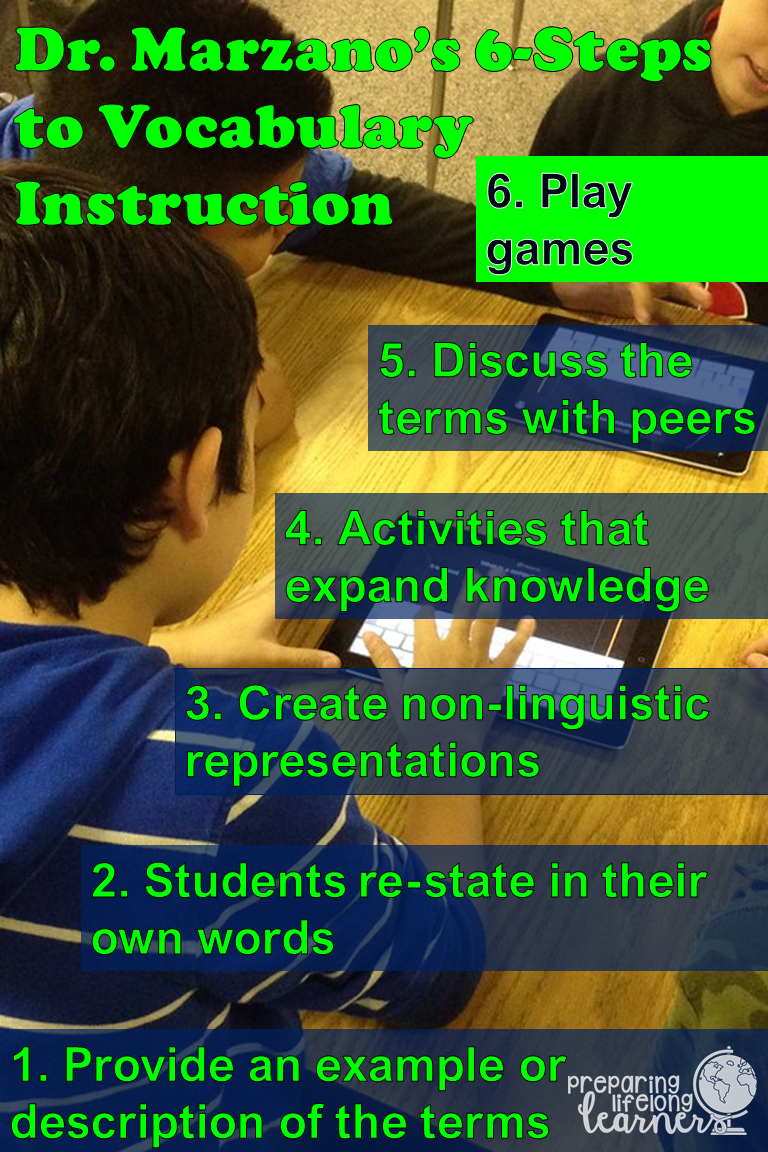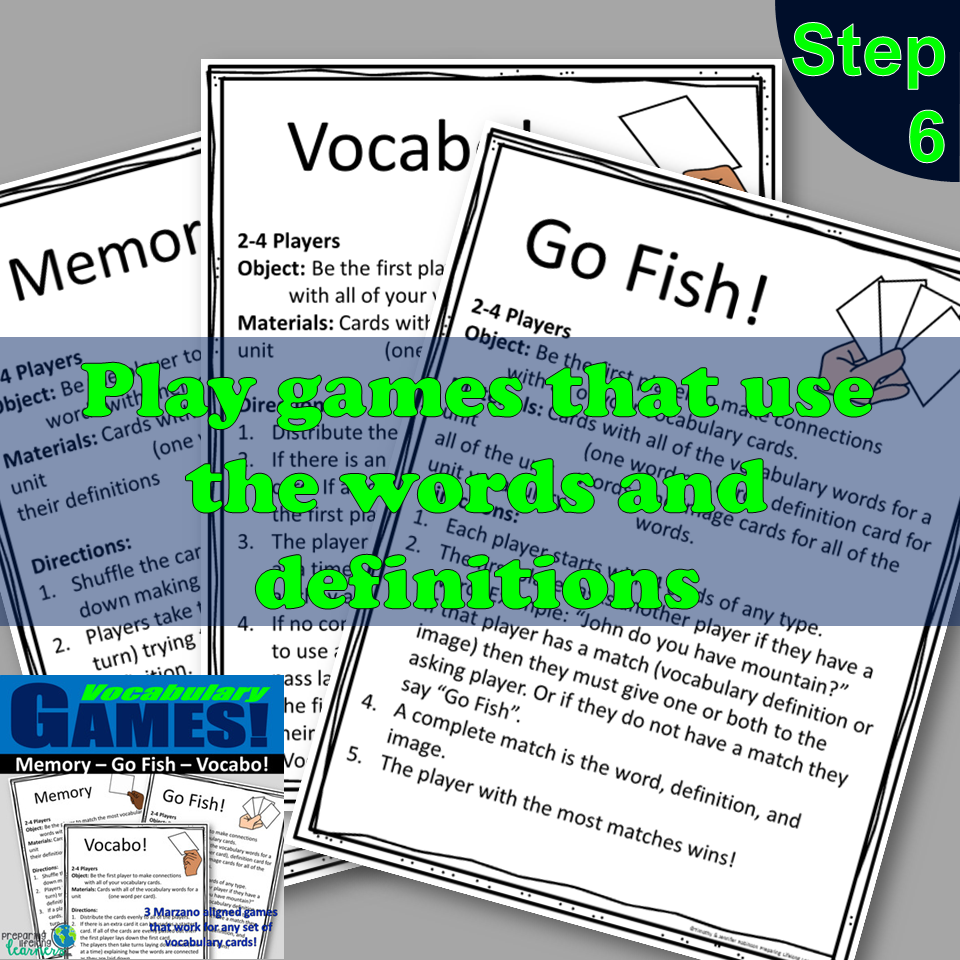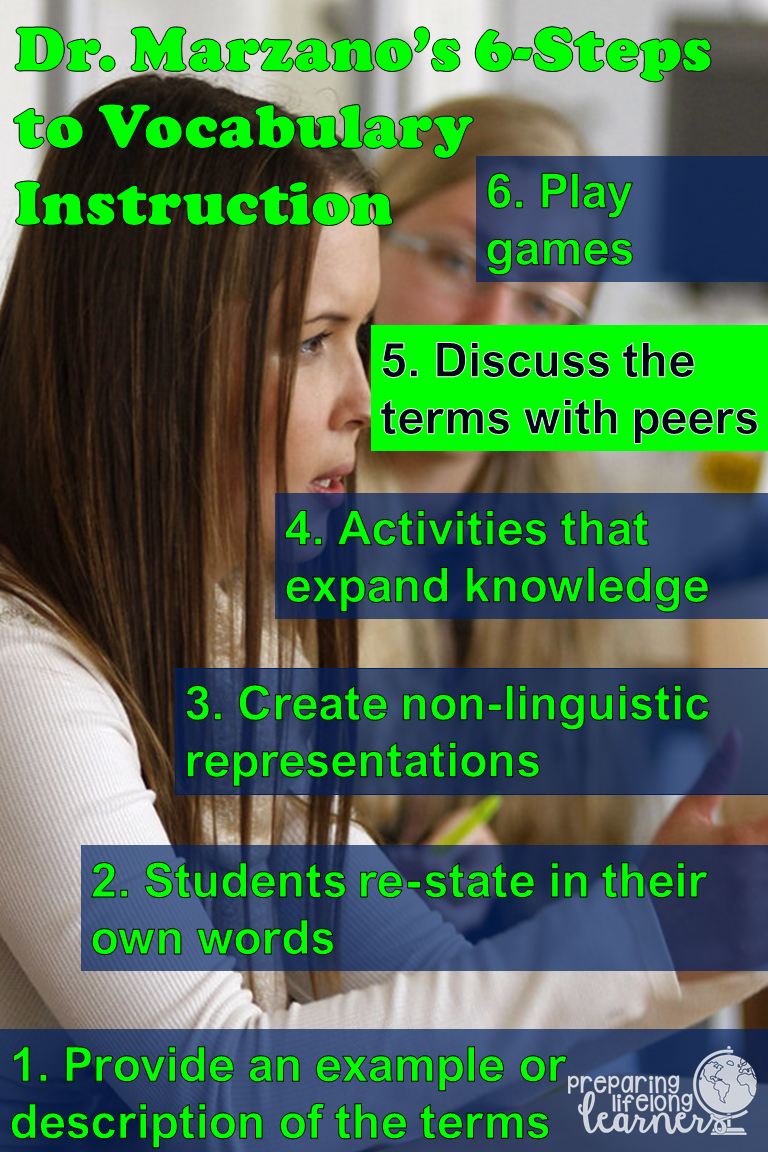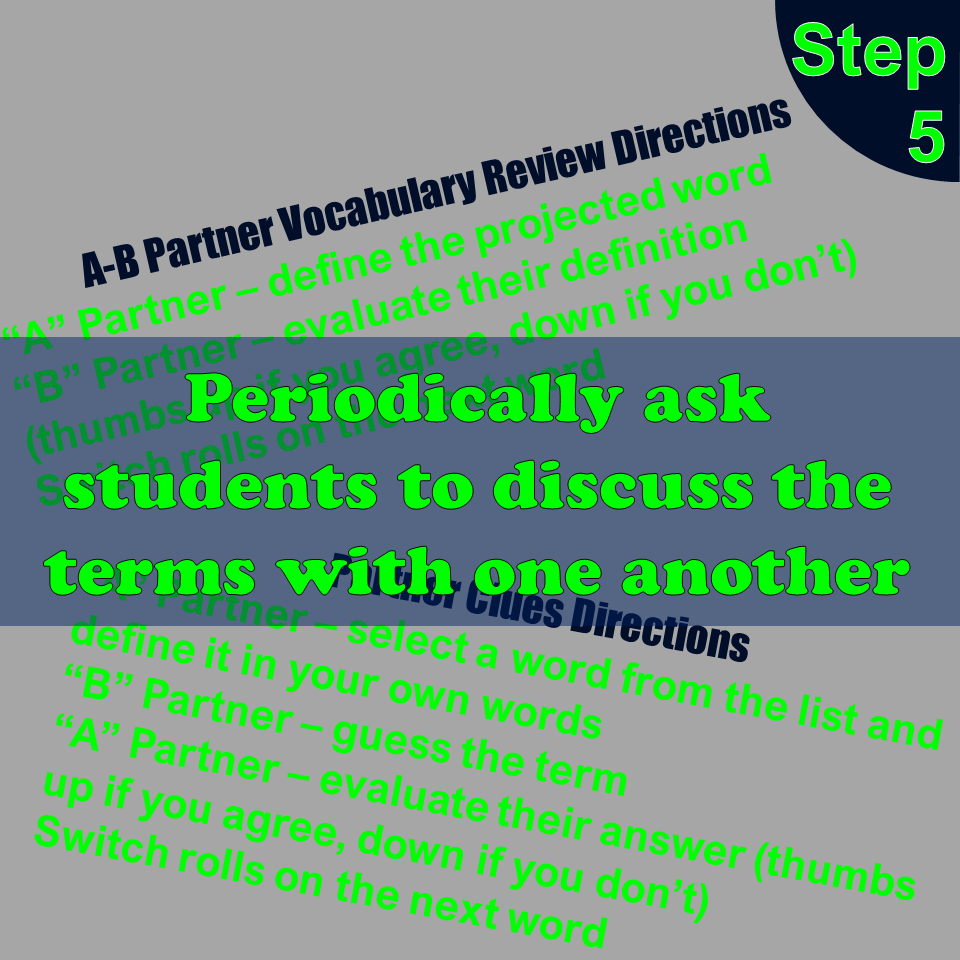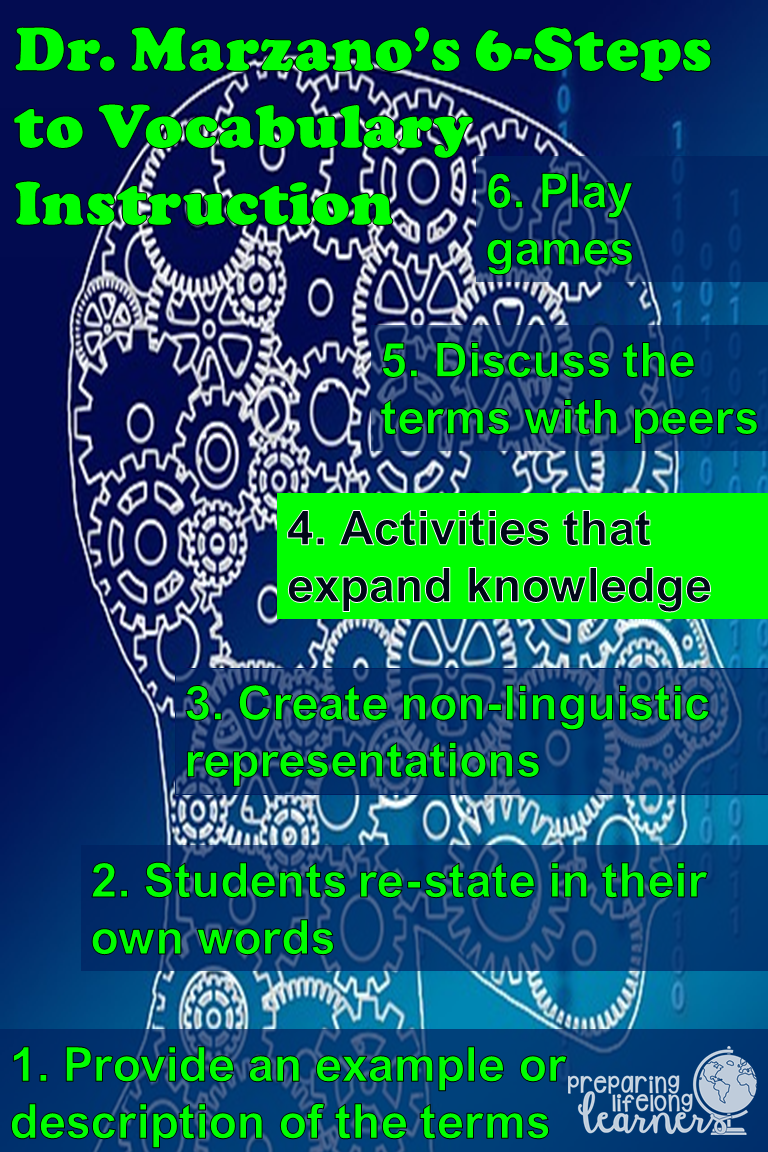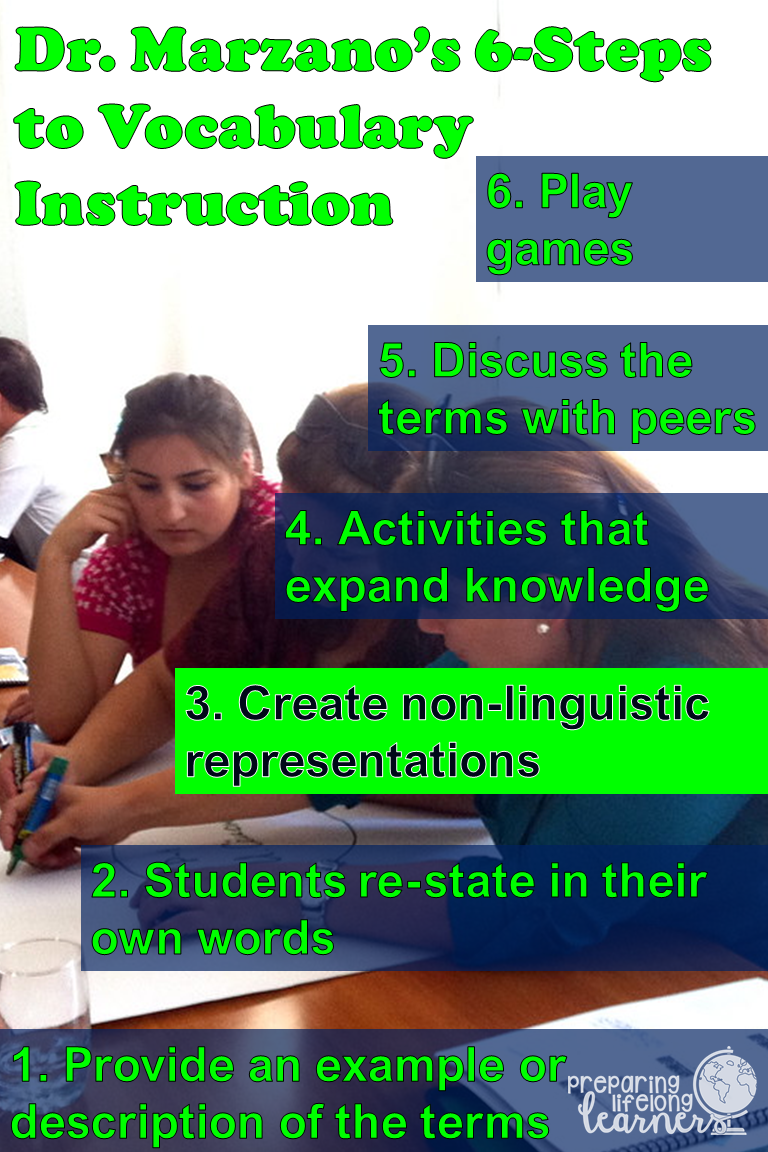|
The last of Dr. Marzano's 6 Steps to Vocabulary Instruction is to play games with the terms. Even though this is the sixth step doesn't necessarily mean it has to come last - it can be done concurrently with the other steps. In fact, it has been my experience that when entwined throughout a unit, the different steps scaffold each other and keep students excited about learning content vocabulary. I love playing games in class. Middle schoolers are nothing if not competitive, and often times say, "Wait, I'm learning..." after our games. These are some of my favorite vocabulary games to use in class...
0 Comments
Marzano's 6 Steps to Vocabulary Instruction #5: Ask students to Discuss Terms with Each Other10/18/2020 Dr. Marzano's fifth step of effective vocabulary instruction is built into steps 2-6 and is a vital component of everything I do in my class regardless of topic. Marzano calls for students to periodically discuss vocabulary terms with each other. I've already mentioned some of these activities in prior posts, but I'll list them again here because they involve students discussing vocabulary with each other. 1. A-B Partner Vocabulary Review - I project one vocab term at a time, and in pairs, one person defines the term. Their partner gives them a "thumbs up" if they agree, or says what they think the correct definition is if they don't. They alternate rolls with each word. I provide 10 seconds per word times 14 words per unit = a 2 minute 20 second vocabulary warm up every single day. To change it up, I will sometimes project the definitions, and students need to recall the word that goes with it. 2. Vocabulary Task Card Activities - Each of the card sort activities call for students to discuss meanings and images of terms with their group. Click HERE for a FREE set of directions for these activities that can be used with any vocabulary task cards. 3. Vocabulary Connections - With partners, or in a group, students are directed to make connections between words and explain and defend those connections to their peers. 4. Vocabo! (and other vocabulary games) - Vocabo! is a vocabulary game I developed which will be explained in more depth in my next post that calls for students to, again, make and defend connections between words, definitions and images. The big difference between Vocabo! and the vocabulary connections activity is that in Vocabo!, they only have a random and limited choice of terms, definitions or images to make connections with. Click HERE for FREE directions to Vocabo! and 2 other vocabulary games that work well with vocabulary task cards. So, be sure to click the links above for the FREE resources mentioned, and don't forget to visit my store for more great Social Studies activities!
By now your students have been introduced to new terms and they have been provided with definitions or examples. They have had opportunities to re-state these definitions in their own words both individually and in groups or pairs and have found ways to represent the words symbolically either through pictures or by acting them out. Great! But now what? Now, Dr. Marzano says to have students engage in activities to refine and add to their understanding of the terms. Don't worry, this is easier than it sounds and doesn't have to be very elaborate or take up that much class time. I do a variety of activities to deepen my students' understanding of our current unit's vocabulary that are fast, easy, take very little prep (yea!) and keep students excited about learning vocabulary! 1. Vocabulary Sentence - I challenge my students to compose a grammatically correct sentence that makes sense using as many of our unit's 14 or so vocabulary terms as possible. Students who think they have created a good one are encouraged to share it out and high scores (most words used) are recorded throughout the day on my big whiteboard.
2. Vocabulary Connections - I project all our vocabulary terms and either as a whole class or with a partner ask for students to explain how two of them are connected. For instance, a student might volunteer and say, "Ziggurats and pyramids are connected because they are both buildings." I would then ask if anyone disagrees or has a different connection. This might get another student to say something like, "I think Ziggurats should go more with mudbrick because that's what ziggurats were made of, and pyramids are stone." The more often you do this activity, the better your students will get at making connections and some will start saying things like, "Ooh! I can connect three!" or "Can I try to connect five?" or, even better, "That word is like _______ from last unit." 3. Fill in the Blanks - I will compose a paragraph using as many of the unit's terms as possible, then I replace the content vocabulary with blanks. My students are then challenged to correctly fill in the blanks. Each of these activities work great as either warm up or filler activities and are certain to result in higher scores on vocabulary quizzes and improved vocabulary retention. If you are interested in other vocabulary resources, be sure to check out the link below, and take a look at the rest of my store for other great Social Studies activities that will get your students engaged in and excited about Social Studies! Okay, your students now have their new terms, definitions you provided and student generated definitions of each term. The majority of your students now have a solid connection with these terms and their definitions. So, now what? Now, you start adding supports - things to really solidify the understanding of students who "get" the terms, and bring more of your students into the fold. But how? Dr. Marzano says to build deeper connections to and understandings of the terms, your students should access the visual part of their brains by making pictures, pictographs or symbolically representing the words in other ways. I do this in several ways, and they are really fun...
All of these can be really fun, get students excited about learning, build great connections with terms and can be used throughout a unit either as warm ups or filler activities. If you want to see more great vocabulary resources, keep following this blog, or click the link below for vocabulary resources I use in my class, and be sure to also visit the rest of my store.
|
MEET TIMI'm an 18 year veteran teacher that loves teaching, coaching, writing, and my family.
Archives
May 2022
|

